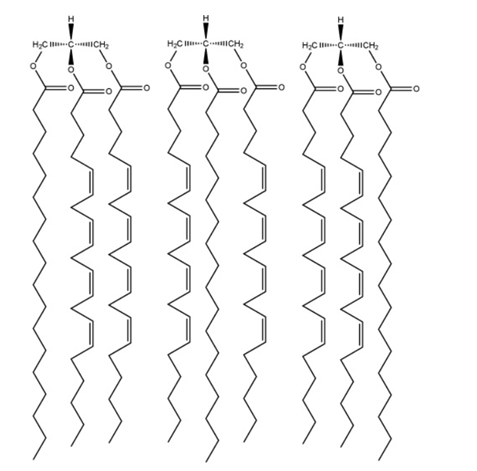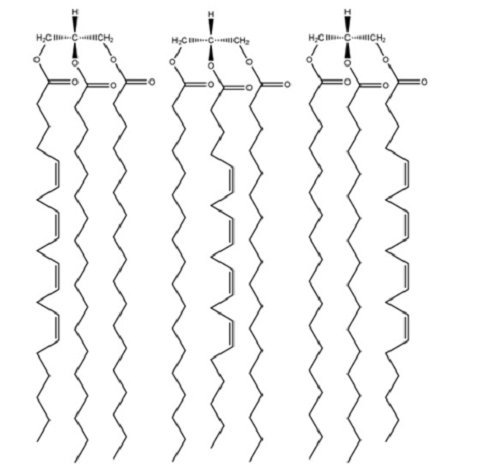
Concept explainers
Answers to all problems are at the end of this book. Detailed solutions are available in the Student Solutions Manual, Study Guide, and Problems Book.
Drawing Structures of Triacylglycerols Draw the structures of (a) all the possible triacylglycerols that can be formed from glycerol with Stearic and arachidonic acid and (b) all the phosphatidylserine isomers that tan be formed from palmitic and linolenic acids.
(a)
To explain:
The formation from glycerol from stearic and arachidonic acid should be described.
Introduction:
Glycerol is the colorless, viscous liquids that belong to the organic group of alcohol. It has three carbon atoms and three hydroxyl groups in its structure that are known as trihydroxyl sugar alcohol.
Explanation of Solution
The chiral molecule is found in the second carbon of glycerol if there is the presence of different substitutes at both ends of carbon. This can lead to the formation of six triacylglycerols from stearic and arachidonic acids as below:


(b)
To explain:
The formation from phosphatidylserine isomers from palmitic and linolenic acids should be described.
Introduction:
A phospholipid with fatty acid is known as phosphatidylserine that covers and protects the cells in the brain and carries messages. It has two fatty acids attached with ester linkage to the C-1 and C-2 of glycerol and serine attached by a phosphodiester linkage to the C-3 of glycerol.
Explanation of Solution
There is a presence of phosphate bonded with a serine residue at C-3 of glycerol in structures of phosphatidylserine. There are two common forms of linolenic acid which means four different phosphatidylserine can be formed from palmitic and linolenic acids as shown below:

Want to see more full solutions like this?
Chapter 8 Solutions
BIOCHEMISTRY (HARDBACK) W/ACCESS CODE
- The following data were recorded for the enzyme catalyzed conversion of S -> P. Question: Estimate the Vmax and Km. What would be the rate at 2.5 and 5.0 x 10-5 M [S] ?arrow_forwardPlease helparrow_forwardThe following data were recorded for the enzyme catalyzed conversion of S -> P Question: what would the rate be at 5.0 x 10-5 M [S] and the enzyme concentration was doubled? Also, the rate given in the table is from product accumulation after 10 minuets of reaction time. Verify these rates represent a true initial rate (less than 5% turnover). Please helparrow_forward
- The following data was obtained on isocitrate lyase from an algal species. Identify the reaction catalyzed by this enzyme, deduce the KM and Vmax , and determine the nature of the inhibition by oxaloacetate. Please helparrow_forwardIn the table below, there are sketches of four crystals made of positively-charged cations and negatively-charged anions. Rank these crystals in decreasing order of stability (or equivalently increasing order of energy). That is, select "1" below the most stable (lowest energy) crystal. Select "2" below the next most stable (next lowest energy) crystal, and so forth. A B 鹽 (Choose one) +2 C +2 +2 (Choose one) D 鹽雞 (Choose one) (Choose one)arrow_forward1. Draw the structures for the fats A. 16:2: w-3 and B. 18:3:49,12,15 2. Name each of the molecules below (image attached)arrow_forward
- draw the structures for the fats A. 16:2:w-3 B 18:3:9,12,15arrow_forward1. Below is a template strand of DNA. Show the mRNA and protein that would result. label the ends of the molecules ( refer to attached image)arrow_forwardAttach the followina labels to the diagram below: helicase, single stranded binding proteins, lagging strand, leading strand, DNA polymerase, primase, 5' ends (3), 3' ends (3) (image attached)arrow_forward
- 1. How much energy in terms of ATP can be obtained from tristearin (stearate is 18:0) Show steps pleasearrow_forwardMultiple choice urgent!!arrow_forward1. Write the transamination reaction for alanine. Indicate what happens next to each of the molecules in the reaction, and under what conditions it happens. 2.arrow_forward
 BiochemistryBiochemistryISBN:9781305577206Author:Reginald H. Garrett, Charles M. GrishamPublisher:Cengage Learning
BiochemistryBiochemistryISBN:9781305577206Author:Reginald H. Garrett, Charles M. GrishamPublisher:Cengage Learning
